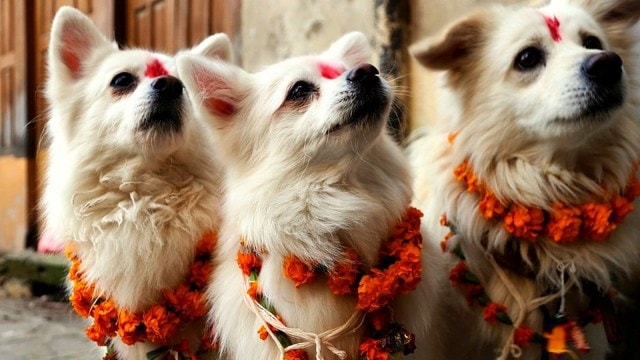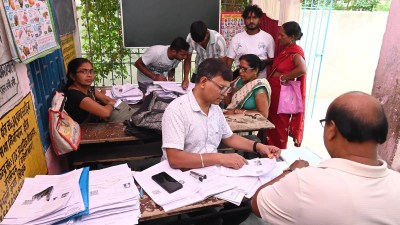📣 For more lifestyle news, click here to join our WhatsApp Channel and also follow us on Instagram
Inside ‘Tihar’, Nepal’s ‘Diwali’ that worships dogs, crows, cows, goddess Laxmi and the bond of siblings
Different communities add their unique touch to Tihar. Among the Sherpa, Tamang, Bhutia, and Gurung communities, themes of light and life are celebrated with distinct rituals and dances.
 For Kukur Tihar, locals adorn their dogs with tikka and garlands, sometimes dressing them in cosy jackets, a thoughtful gesture against the evening chill that begins to wrap Kathmandu valley October onwards.
For Kukur Tihar, locals adorn their dogs with tikka and garlands, sometimes dressing them in cosy jackets, a thoughtful gesture against the evening chill that begins to wrap Kathmandu valley October onwards.Around the same time India celebrates Diwali, Nepal too enters into a festive spirit with Tihar. Known as a ‘festival of lights,’ this five-day celebration involves honouring the goddess Laxmi, along with unique traditions of worshipping crows, dogs, oxen, and in some communities, even oneself. The festival, as this writer learned during her recent visit to Kathmandu, begins with Kaag Tihar.
“Kaag, or crows, are seen as messengers of Yamraj, the god of death. We worship them, placing a tikka on their heads, and offering garlands and food,” shares Bibek Shrestha, senior sales manager at Kathmandu Marriott Hotel, and a member of the Newar community, which is considered as the indigenous inhabitants of the Kathmandu Valley in Nepal. Worshipping crows, locals believe, appeases them, protecting households from misfortune and grief in the coming year.
The following day is celebrated as Kukur Tihar. Here, the affection for dogs is on full display—especially around Kathmandu Durbar Square, where is a perfect stop to enjoy a traditional Newari thali featuring savoury black lentil pancakes (Bara), beaten rice, spicy smoked buff Choila, a black soybean salad (bhatmas), spicy potato salad (Alu Sandeko), a portion of green saag, and Yomari, a dumpling dessert filled with jaggery. It is served with Aila or Cheng, homemade liquors made from fermented rice. Dogs could be seen roaming freely through common areas, welcomed into eateries. For Kukur Tihar, locals adorn their dogs with tikka and garlands, sometimes dressing them in cosy jackets, a thoughtful gesture against the evening chill that begins to wrap Kathmandu valley October onwards. The celebrations extend beyond pets to street dogs, who are also pampered with food and affection.
 Adding to the fervour of Laxmi Puja are the vibrant folk performances of Bhailo and Deusi.
Adding to the fervour of Laxmi Puja are the vibrant folk performances of Bhailo and Deusi.
Laxmi Puja in Nepal mirrors India’s Diwali: households and businesses keep their doors open, inviting goddess Laxmi’s blessings for prosperity. Marigold decoration, rangolis, and the goddess’s symbolic footprints adorn homes and shops. It’s not really a surprise considering 81.19 per cent of the population in Nepal is Hindu with a prominent presence of the Marwari community. The shopkeepers in Nepal, many of whom have Indian roots, join in by lighting up their stores for the goddess’s arrival. As it is in India, the usage of electronic lights, we learnt from the locals, have increased lately but people still feel nostalgic about lighting oil lamps.
Adding to the fervour of Laxmi Puja are the vibrant folk performances of Bhailo and Deusi. Traditionally, Bhailo is performed by women on Laxmi Puja night, while Deusi follows the next day with male performers. Nowadays, however, both are often celebrated together, featuring door-to-door singing and well-wishing, accompanied by traditional drums like the madal. In return for their blessings, performers receive gifts or offerings from the homeowners.
The day after Laxmi Puja is Gobhardhan Puja, dedicated to honouring oxen, while the festival’s final day is Bhai Tika, a sibling ceremony similar to India’s Bhai Dooj. On this day, sisters apply a seven-coloured ‘Saptrangi’ tikka on their brothers’ foreheads, who touch their sister’s feet for blessing and give her a present.
 Sel Roti is a deep-fried, crispy rice doughnut.
Sel Roti is a deep-fried, crispy rice doughnut.
In Newari communities, Bhai Tika includes drawing rangolis for each sibling, along with one dedicated to Lord Ganesha. Shrestha notes that on this day, not only does he buy a present for his sister but he also receives dry fruits, fruits, and even alcohol from her as part of the celebration. For the Newaris, alcohol is not taboo; it is an integral part of festive occasions, including birthdays and Tihar. In fact, some even believe that Cheng (local rice beer) promotes milk production in breastfeeding women, allowing it for pregnant and lactating women as well.
The Newaris, which constitute nearly half of the population in the Kathmandu Valley, Tihar sees an additional day of festivities. Dedicated to self-worship, it is called Moh Puja. “This day is about celebrating ourselves, thanking the lord and our kuldevta (ancestral deities),” says Shrestha. In this unique ritual, a traditional container (mana) is filled with rice, adorned with flowers and Saptrangi tikka, and then emptied over one’s head in a gesture of self-honour.
Different communities add their unique touch to Tihar. Among the Sherpa, Tamang, Bhutia, and Gurung communities, themes of light and life are celebrated with distinct rituals and dances. “For instance, some communities light lamps to ward off negative spirits and honour specific deities associated with nature and prosperity,” explains a local.
 Worshipping crows, locals believe, appeases them, protecting households from misfortune and grief in the coming year.
Worshipping crows, locals believe, appeases them, protecting households from misfortune and grief in the coming year.
They say any festival is incomplete without sweets and that stands true to Tihar as well. While popular mithais like lal mohan (gulab jamun), peda, and barfi are enjoyed widely, local treats hold a special place and are exchanged between the family and visitors. “We have Sel Roti, a deep-fried, crispy rice doughnut often enjoyed as a main treat; Yomari, made from fine rice flour kneaded slowly and filled with jaggery; and Laakhamari, a crunchy sweet made from flour and sugar, shaped into unique designs and ranging from 4 to 12 inches in diameter,” shares Suman Maharjan, head of food and beverages at Kathmandu Marriott Hotel.
As with Diwali in India, Nepalese Tihar dates can overlap due to astrological alignments. “We follow the local calendar,” says Shrestha, adding that with Tihar, Nepal enters a new year. “We are in the year 1144, and on Saturday, we’ll celebrate the sambat (New Year) and welcome 1145.”
This writer was in Nepal at the invite of Kathmandu Marriott Hotel
📣 For more lifestyle news, click here to join our WhatsApp Channel and also follow us on Instagram



- 01
- 02
- 03
- 04
- 05
























